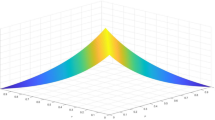Abstract
Similarity measure design on non-overlapped data was carried out and compared with the case of overlapped data. Unconsistant feature of similarity on overlapped data to non-overlapped data was provided by example. By the artificial data illustration, it was proved that the conventional similarity measure was not proper to calculate the similarity measure of the non-overlapped case. To overcome the unbalance problem, similarity measure on non-overlapped data was obtained by considering neighbor information. Hence, different approaches to design similarity measure were proposed and proved by consideration of neighbor information. With the example of artificial data, similarity measure calculation was carried out. Similarity measure extension to intuitionistic fuzzy sets (IFSs) containing uncertainty named hesitance was also followed.
Similar content being viewed by others
References
ZADEH L A. Fuzzy sets and systems [C]// Proc Symp on Systems Theory. New York: Polytechnic Institute of Brooklyn, 1965: 29–37.
PAL N R, PAL S K. Object-background segmentation using new definitions of entropy [J]. IEEE Proceedings of Computer and Digital Techniques, 1989, 136(4): 284–295.
KOSKO B. Neural networks and fuzzy systems [M]. Englewood Cliffs, NJ: Prentice-Hall, 1992.
LIU Xue-cheng. Entropy, distance measure and similarity measure of fuzzy sets and their relations [J]. Fuzzy Sets and Systems, 1992, 52: 305–318.
BHANDARI D, PAL N R. Some new information measure of fuzzy sets [J]. Inform Sci, 1993, 67: 209–228.
DELUCA, TERMINI S. A Definition of nonprobabilistic entropy in the setting of fuzzy entropy [J]. J General Systems, 1972, 5: 301–312.
HSIEH C H, CHEN S H. Similarity of generalized fuzzy numbers with graded mean integration representation [C]// Proc 8th Int Fuzzy Systems Association World Congr. Taipei: ISFA, 1999, 2: 551–555.
CHENS J, CHEN S M. Fuzzy risk analysis based on similarity measures of generalized fuzzy numbers [J]. IEEE Trans on Fuzzy Systems, 2003, 11(1): 45–56.
LEE S H, PEDRYCZ W, SOHN G Y. Design of similarity and dissimilarity measures for fuzzy sets on the basis of distance measure [J]. International Journal of Fuzzy Systems, 2009, 11: 67–72.
LEE S H, RYU K H, SOHN G Y. Study on entropy and similarity measure for fuzzy set [J]. IEICE Trans Inf & Syst, 2009, E92-D: 1783–1786.
LEE S H, KIM S J, JANG N Y. Design of fuzzy entropy for non convex membership function [J]. Communications in Computer and Information Science, 2008, 15: 55–60.
DENG L, CHUN C. New similarity measure of intiotionistic fuzzy sets and application to pattern recognitions [J]. Pattern Recognotion Letter, 2002, 23: 221–225.
LI Yan-hong, OLSON D L, QIN Zheng. Similarity measures between intuitionistic fuzzy (vague) set: A comparative analysis [J]. Pattern Recognition Letter, 2007, 28: 278–285.
ATANASSOV K. Intuitionistic fuzzy sets [J]. Fuzzy Set and System, 1986, 20: 87–96.
ATANASSOV K. Intuitionistic fuzzy sets: Theory and applications [M]. Heidelberg, Physica-Verlag, 1999.
Author information
Authors and Affiliations
Corresponding author
Rights and permissions
About this article
Cite this article
Lee, Sh., Shin, Ss. Similarity measure design on overlapped and non-overlapped data. J. Cent. South Univ. 20, 2440–2446 (2013). https://doi.org/10.1007/s11771-013-1754-x
Received:
Accepted:
Published:
Issue Date:
DOI: https://doi.org/10.1007/s11771-013-1754-x




